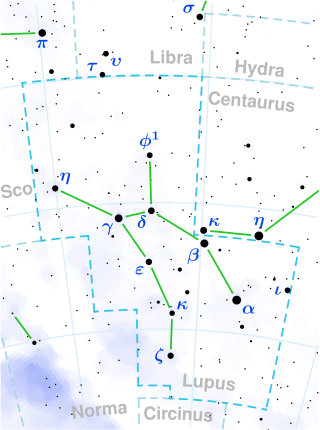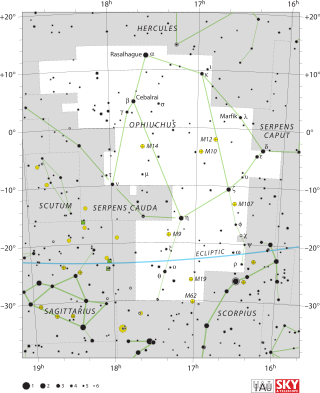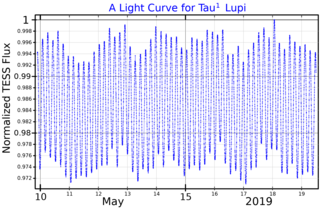
Delta Crucis or δ Crucis, also identified as Imai, is a star in the southern constellation of Crux, and is the faintest of the four bright stars that form the prominent asterism known as the Southern Cross. This star has an apparent magnitude of 2.8, and its proper name was adopted by the International Astronomical Union on 10 August 2018. Imai is a massive, hot and rapidly rotating star that is in the process of evolving into a giant, and is located at a distance of about 345 light-years from the Sun.

Alpha Lupi is a blue giant star, and the brightest star in the southern constellation of Lupus. According to the Bortle Dark-Sky Scale, its apparent visual magnitude of 2.3 makes it readily visible to the naked eye even from highly light-polluted locales. Based upon parallax measurements made during the Hipparcos mission, the star is around 460 light-years from the solar system. It is one of the nearest supernova candidates.

Eta Centauri, Latinized from η Centauri, is a star in the southern constellation of Centaurus. It has an apparent visual magnitude of +2.35 and is located at a distance of around 306 light-years.

Epsilon Centauri is a star in the southern constellation of Centaurus. It is one of the brightest stars in the constellation with a slightly variable apparent visual magnitude of +2.30. Parallax measurements put it at a distance of around 430 light-years from Earth.
42 Camelopardalis is a single star in the constellation Camelopardalis, located roughly 770 light years away from the Sun. It is visible to the naked eye as a faint, blue-white hued star with an apparent visual magnitude of 5.14. The visual magnitude of the star is diminished by an extinction of 0.22 due to interstellar dust. It is moving further from the Earth with a heliocentric radial velocity of 3 km/s. 42 Camelopardalis has a peculiar velocity of 24.4+1.9
−2.1 km/s and may be a runaway star.

Kappa Centauri is a binary star in the southern constellation of Centaurus. With an apparent visual magnitude of +3.14, it can be viewed with the naked eye on a dark night. Parallax measurements place it at an estimated distance of 380 light-years from Earth.

Nu Centauri, Latinized from ν Centauri, is a binary star system in the southern constellation of Centaurus. The combined apparent visual magnitude of the pair is +3.41, making this one of the brightest members of the constellation. Based upon parallax measurements made during the Hipparcos mission, this star system is located at a distance of roughly 437 light-years from Earth. The margin of error for this distance is about 2%, which is enough to give an error in distance of ±10 light years.
HD 102776, also known by its Bayer designation j Centauri, is a suspected astrometric binary star system in the southern constellation of Centaurus. It has a blue-white hue and is faintly visible to the naked eye with a typical apparent visual magnitude of 4.30. The distance to this star is approximately 600 light years based on parallax, and it is drifting further away with a radial velocity of ~29 km/s. It is a member of the Lower Centaurus Crux subgroup of the Sco OB2 association. HD 102776 has a relatively large peculiar velocity of 31.1 km/s and is a candidate runaway star that was ejected from its association, most likely by a supernova explosion.
Chi Centauri is a star in the constellation Centaurus.
Zeta Crucis, Latinized from ζ Crucis, is a binary star system in the southern constellation of Crux. It is visible to the naked eye with an apparent magnitude of 4.06m. ζ Crucis is located at about 360 light-years from the Sun. It is a member of the Lower Centaurus–Crux subgroup of the Scorpius–Centaurus association.

Beta Lupi or Kekouan, is a star in the southern constellation of Lupus. It has an apparent visual magnitude of 2.7, making it readily visible to the naked eye. Based upon parallax measurements, this star is located at a distance of about 383 light-years from Earth.

Delta Lupi is a star in the southern circumpolar constellation of Lupus. In traditional Chinese astronomy, it is "the 2nd (star) of the Cavalry Officer" (騎官二). With an apparent visual magnitude of 3.2, it is the fourth-brightest star in the constellation. The distance to this star has been measured using the parallax technique, yielding an estimate of roughly 900 light-years with a 15% margin of error.

Theta Ophiuchi, Latinized from θ Ophiuchi, is a multiple star system in the equatorial constellation of Ophiuchus. It lies on the "right foot" of the serpent-bearer, just southwest of Kepler's Star, the nova of 1604. According to Richard H. Allen's Star Names: Their Lore and Meaning (1899), θ Oph together with ξ Oph formed the Sogdian Wajrik "the Magician", the Khorasmian Markhashik "the Serpent-bitten" and with η Oph the Coptic Tshiō, "the Snake", and Aggia, "the Magician". This star has an apparent visual magnitude of +3.3, making it readily visible to the naked eye. Based upon parallax measurements from the Hipparcos mission, it is roughly 436 light-years from Earth. It is 1.8 degrees south of the ecliptic and therefore subject to lunar occultations and less frequently occulted by a planet.
Pi2 Cygni, Latinized from π2 Cygni, is a triple star system in the northern constellation of Cygnus. It is visible to the naked eye about 2.5° east-northeast of the open cluster M39, having an apparent visual magnitude of 4.24. Based upon an annual parallax shift of 2.95 mas, it is located at a distance of roughly 1,100 light years from the Sun.

Alpha Muscae, Latinized from α Muscae, is a star in the southern circumpolar constellation of Musca. With an apparent visual magnitude of +2.7, it is the brightest star in the constellation. The distance to this star has been determined using parallax measurements, giving an estimate of about 315 light-years from Earth.

Chi Ophiuchi, Latinized from χ Ophiuchi, is a variable star in the equatorial constellation of Ophiuchus. It has a blue-white hue and is faintly visible to the naked eye with an apparent visual magnitude that fluctuates around 4.22. The distance to this object, as determined from parallax measurements, is approximately 500 light years, but it is moving closer to the Sun with a radial velocity of −19 km/s. This star is a proper motion member of the Upper Scorpius sub-group in the Scorpius–Centaurus OB association; the nearest such co-moving association of massive stars to the Sun.

CH Crucis is a solitary variable star in the southern constellation of Crux. It has the Gould designation 35 G. Crucis. The object is visible to the naked eye as a faint, blue-white hued point of light with an apparent visual magnitude that fluctuates around 4.91. The star is located approximately 780 light years distant from the Sun based on parallax, and is drifting further away with a radial velocity of about +12.5 km/s. It is a member of the nearby Sco OB2 association.

Lambda Eridani is a star in the constellation Eridanus. It is visible to the naked eye on a dark night with an apparent visual magnitude of 4.27. The distance to this star, based upon an annual parallax shift of 0.00402 arcseconds, is roughly 810 light years.

KT Lupi is a visual binary star system in the constellation Lupus. It is visible to the naked eye with a combined apparent visual magnitude of 4.55. As of 1983, the pair had an angular separation of 2.19″±0.03″. Based upon an annual parallax shift of 7.6 mas as seen from Earth's orbit, it is located 430 light-years from the Sun. The system is moving further from the Earth with a heliocentric radial velocity of +6.5 km/s. It is a member of the Lower Centaurus–Crux sub-group of the Scorpius–Centaurus association.

Tau1 Lupi, Latinized from τ1 Lupi, is a solitary star in the southern constellation of Lupus. It is visible to the naked eye with an apparent visual magnitude of 4.5. Based upon an annual parallax shift of only 2.99 mas as seen from Earth, it is located about 1,090 light years from the Sun. Tau1 Lupi may be a runaway star having a peculiar velocity of 32.6±3.6 km/s. It is a member of the Upper Centaurus–Lupus sub-group of the nearby Sco OB2 association.













